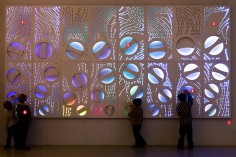Micah Scott
Forest
source: miscname
Step into a luminous forest growing from floor to ceiling and navigate your way through twisting organic strands and interactive paths where bubbles of light slosh and flow, in this large-scale interactive light sculpture that encourages play, curiosity, and collaboration.
Forest is a creative collaboration between internationally acclaimed visual and new media artist Micah Elizabeth Scott and the New Media program at Ryerson University’s RTA School of Media. This work is commissioned by TIFF for the 2015 digiPlaySpace.
While San Francisco-based Scott provided artistic concept and technical leadership, a group of Ryerson New Media students, led by Steve Daniels and David Bouchard, collaborated with Scott to design and fabricate this sophisticated, interactive digital artwork in Toronto.
.
.
.
.
.
.
.
source: torontolife
Every March, the TIFF Bell Lightbox hosts digiPlaySpace, an exhibition of kid-friendly interactive art. This year’s marquee installation is Forest, a co-creation of new-media artist Micah Elizabeth Scott and 26 students from Ryerson University’s new-media program. It’s a massive digital canvas made up of over 7,500 LEDs and controlled by software Scott developed herself. Young visitors interact with the piece by turning wooden spinners with their hands. “I designed something that wasn’t a screen,” Scott explains, “something that has a lot of real, tactile sense to it, and isn’t just fingers sliding against glass.” Here’s an annotated look at how it works.
The sculpture is 16 feet wide and eight feet tall, and it weighs over 600 pounds. It took about six weeks to build and two days to install.
The body of the installation, including the spinners, is made of medium density fibreboard. “It’s literally from the Home Depot,” says Steve Daniels, a Ryerson professor who helped coordinate the project. He used a CNC router at Ryerson’s Maker Space to cut it into shape.
Coloured lights seem to move along swirling paths towards the top of the wall. The lights appear to flow around obstacles. “It’s a familiar physical interaction, but put into a completely unfamiliar context, where something behaves like fluid but looks like light,” Scott says.
To manipulate the light, people can turn the dial-like spinners, which “push” the colours along set paths, mixing them together and changing the direction of the flow. “So, while one person might be spinning dials and having very specific local impact on the colour and the flow on the wall, that impact’s also rippling out and affecting the way their neighbours are experiencing the piece,” Daniels says.
The sculpture senses movement using rainbow-hued stickers that are affixed to the back of each spinner. When someone spins a spinner, the rainbow sticker spins as well. A colour sensor reads the sticker’s movement and relays that information to the computer that controls the lights.
The spinners are mostly low enough to the ground that kids can grab them with ease.
.
.
.
.
.
.
.
source: scanlimeusesthis
My name is Micah Elizabeth Scott. I’ve been doing unconventional things with technology for as long as I can remember, often exploring the boundaries between software and hardware. I’ve built satellites, robots, virtual machines, graphics drivers, CPU emulators, networking stacks, USB controllers, reverse engineering tools, and pretty much everything in-between.
I worked at VMware for six years, doing mostly USB and GPU virtualization. For about the last year, I’ve been at Sifteo building a new kind of video game console. Now I’m following my own path for a while, exploring ways to mix software, hardware, and art.


